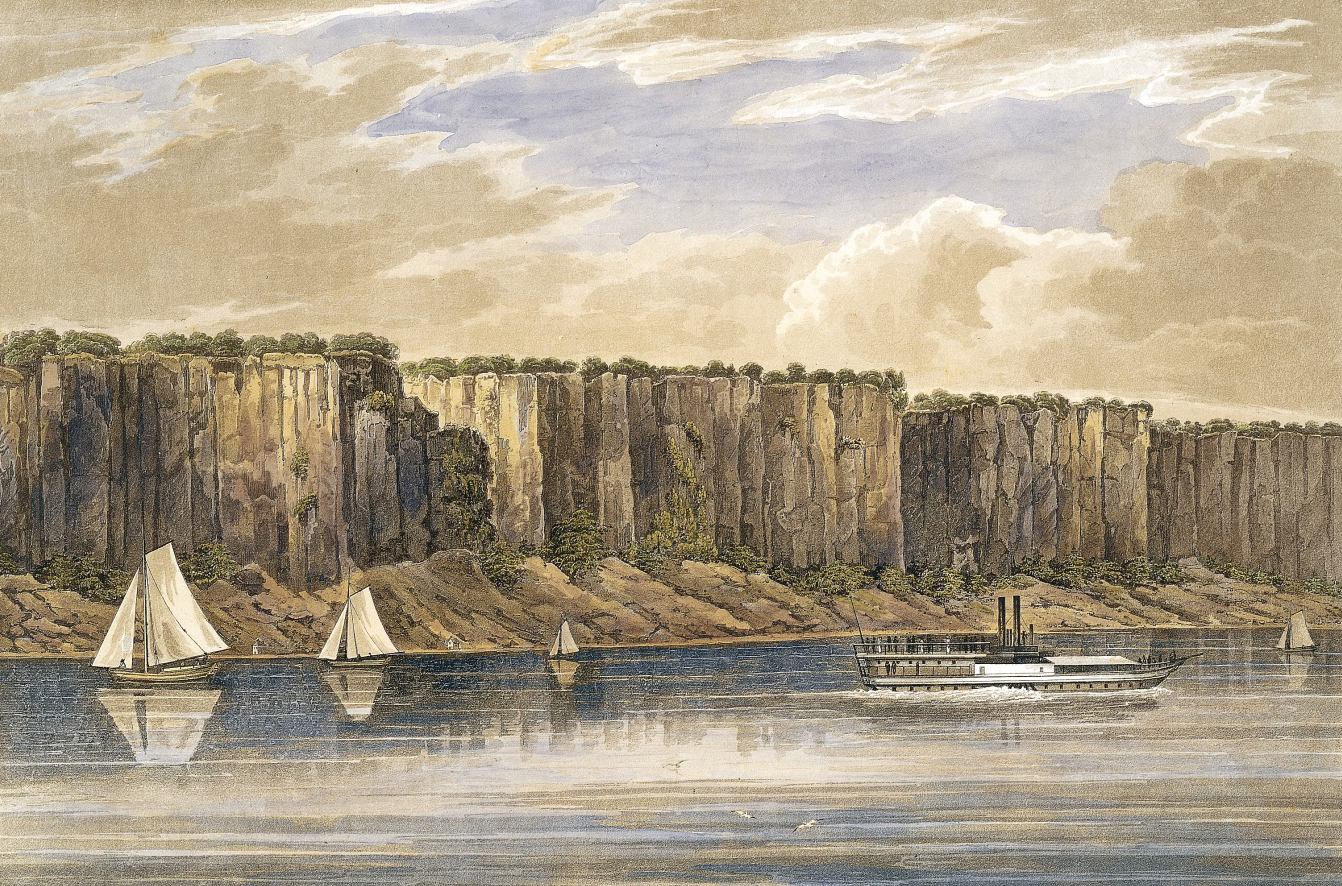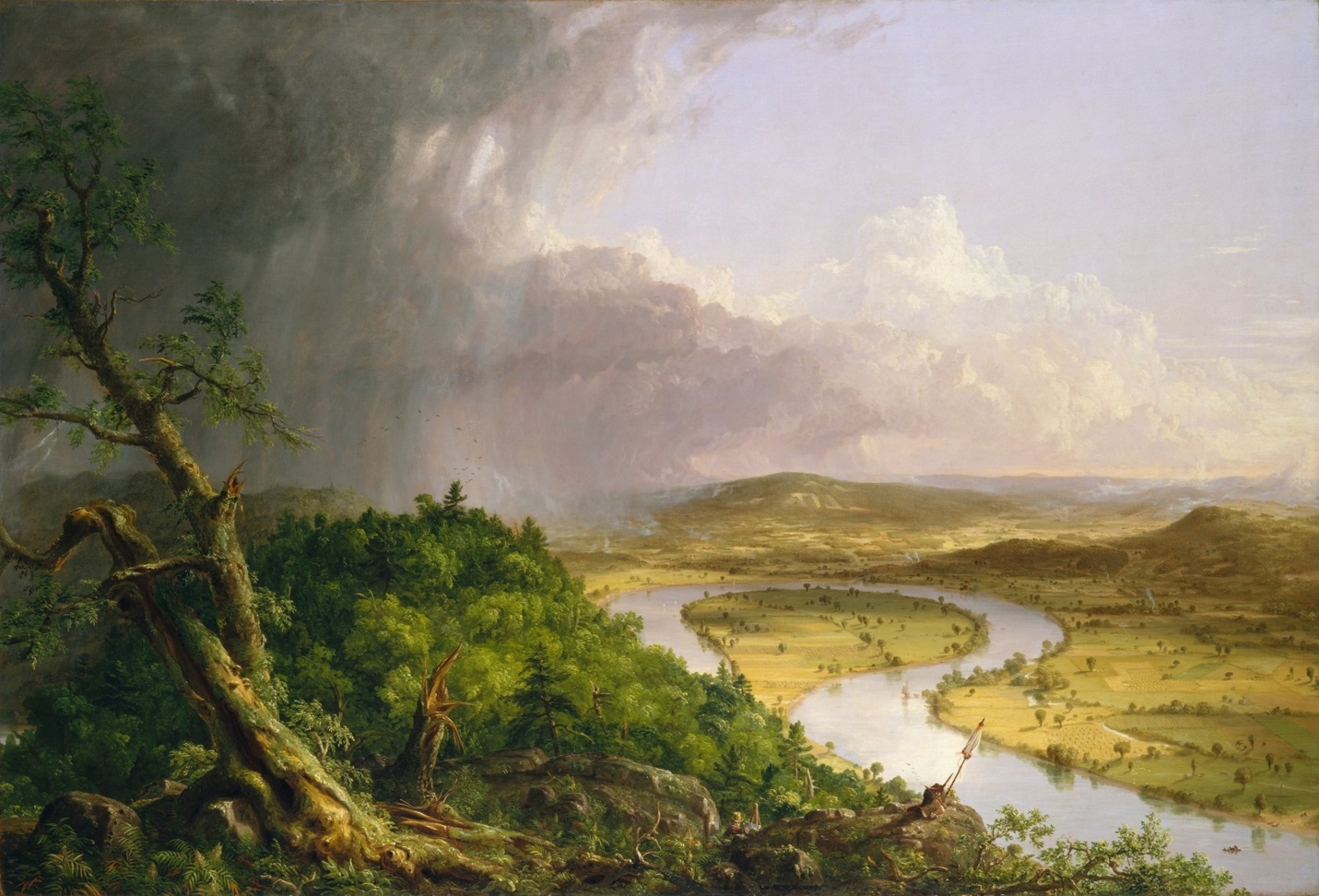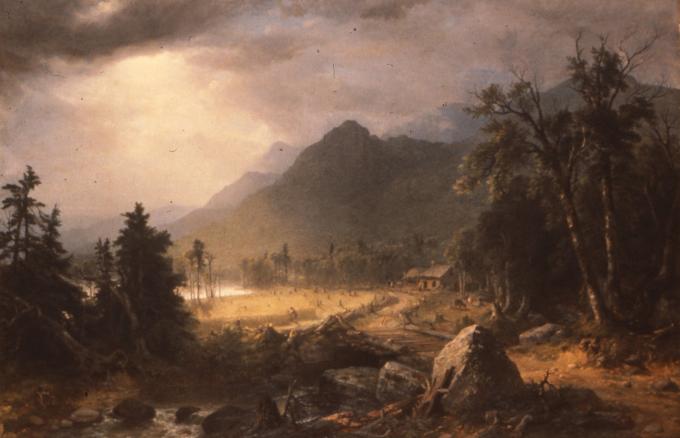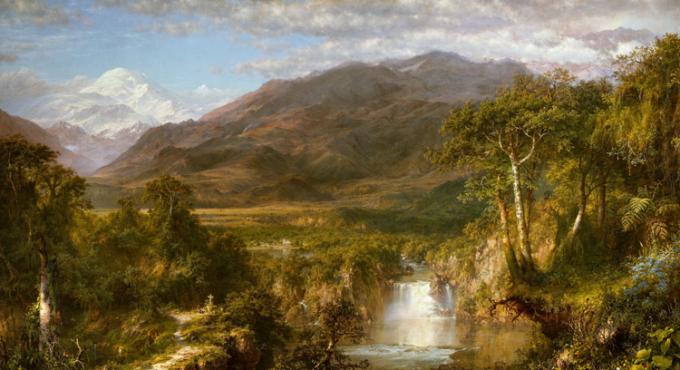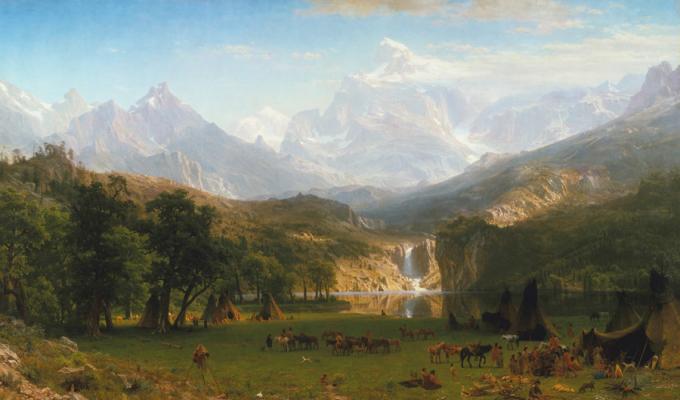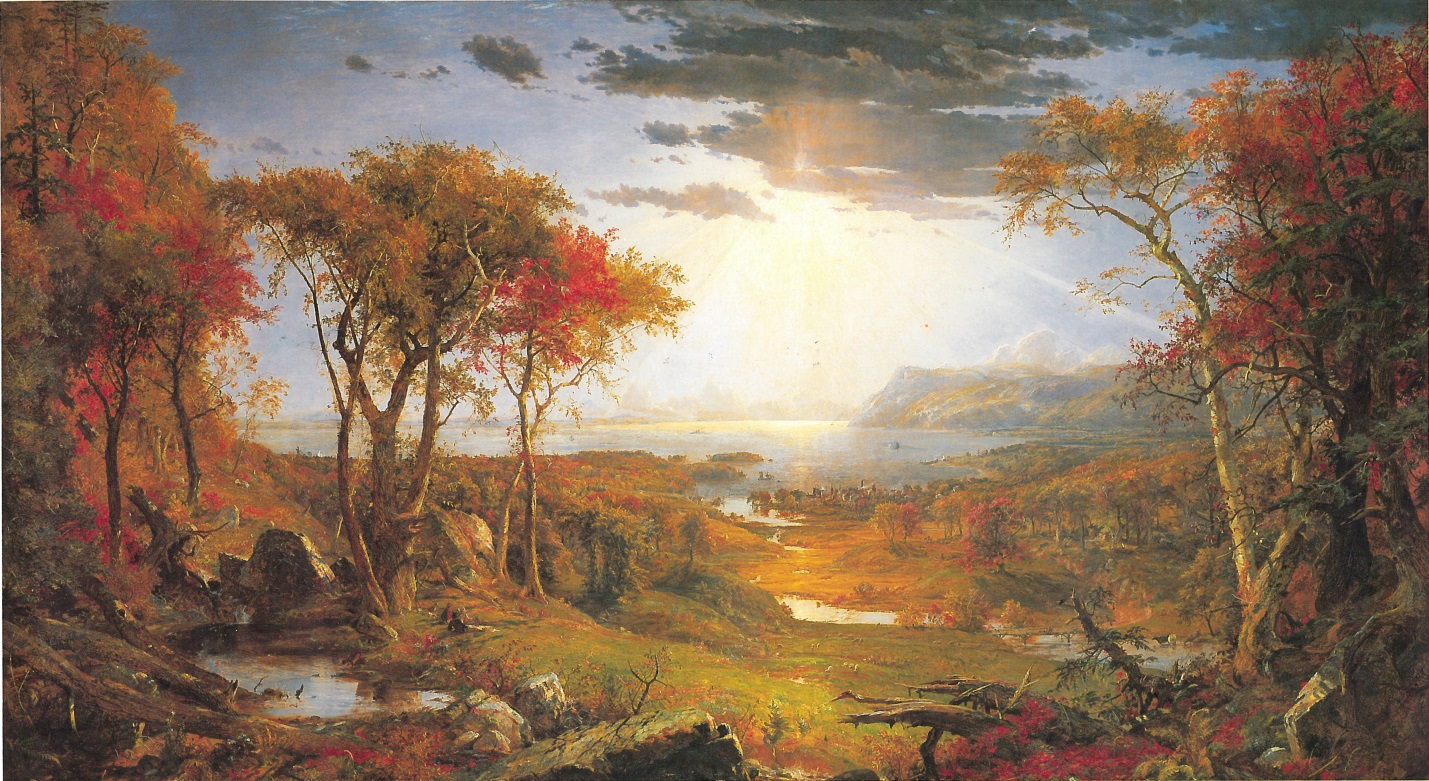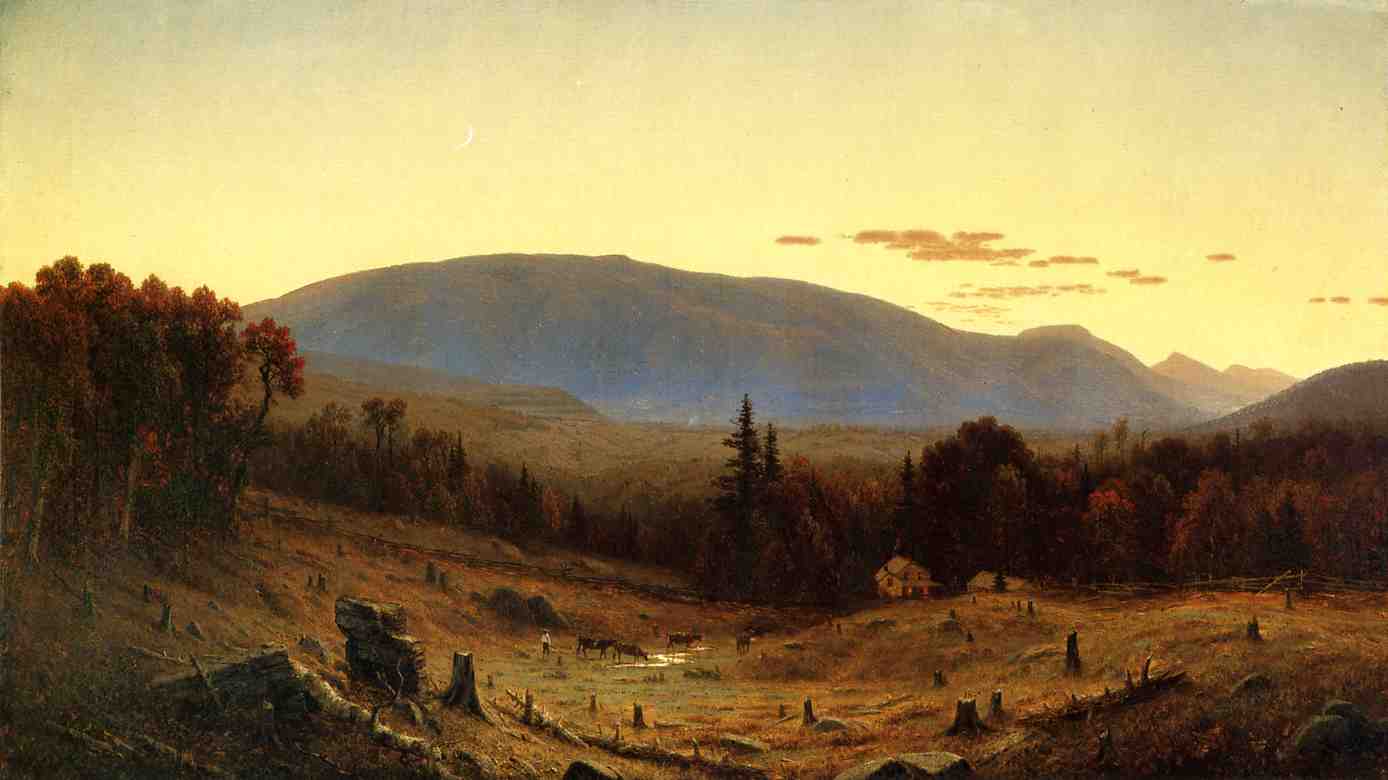"Nature’s Nation": The Hudson River School and American Landscape Painting, 1825–1876
by Linda Ferber
Introduction
The late nineteenth-century critic who first referred to a "Hudson River School" intended the nickname to be dismissive, describing artists whose style was old fashioned and whose American subjects were provincial. The term long ago lost its negative meaning and is now accepted as shorthand for a group of artists active in New York City from the early years of the nineteenth century. Together with like-minded poets and writers, they forged a self-consciously "American" landscape vision and literary voice. Both vision and voice were grounded in the exploration of American scenery as a resource for spiritual renewal and as an expression of cultural and national identity. Their vision of American nature prevailed from 1825 and peaked in the middle years of the century, waning in the years following the Civil War. Hudson River School artists found their subjects on sketching expeditions in the Hudson River Valley, the Catskills, the Adirondacks, and the White Mountains. After 1850, they also sought inspiration farther from home, documenting wilderness experiences in the West, the Far North, and South America. American landscape painters also traveled to Europe, as did their patrons, confronting and interpreting long-venerated Old World sites. Nonetheless, the long-standing preference of artists and collectors during this period was for American scenery. An astute critic, James Jackson Jarves, observed in 1864 that "the thoroughly American branch of painting, based upon the facts and tastes of the country and people, is the landscape. It surpasses all others in popular favor, and may be said to have reached the dignity of a national school."
This brief survey will cover only a few of these influential artists and their paintings. I discuss them within the rich context of nineteenth-century landscape commentary to show how and why American landscape imagery as visualized in the paintings of the Hudson River School emerged around 1825 as a narrative force that presented important ideas about nature and nationhood. The authority behind that narrative was derived from the ongoing quest for national identity and territorial expansion. Both missions were grounded in the belief that what defined Americans was their relationship with the land.
The Language of American Landscape: Nature’s Nation
Intellectual historian Perry Miller’s perceptive characterization of America as "nature’s nation" describes the fundamental nineteenth-century belief that the destiny of the United States and the spiritual welfare of its citizens were somehow inextricably linked to the republic’s terrestrial environment. The seemingly limitless continental spaces and natural resources, although raw and uncultivated when compared with those of Europe, were seen to guarantee a glorious national future. The same wilderness conditions generated an American mythic past, as evoked by novelist James Fenimore Cooper in the adventures of frontiersman Natty Bumppo in The Leatherstocking Tales (1823–1841). In addition to literature, abundant exhibition reviews, art criticism, and discussions of national taste show that the prevalence of this belief also fueled a widespread enthusiasm for paintings of American scenery that peaked during the middle decades of the nineteenth century.
DeWitt Clinton Addresses the American Academy of the Fine Arts
In 1816, DeWitt Clinton, champion of the Erie Canal project and soon to be the governor of New York State, addressed the American Academy of the Fine Arts in New York City. Clinton declared that "[a] Republican government, instead of being unfriendly to the growth of the Fine Arts, is the appropriate soil for their cultivation." He presented a case for the unique status of landscape painting in America, claiming, "Here Nature has conducted her operations on a magnificent scale . . . [C]an there be a country in the world better calculated than ours . . . to afford just views of the beautiful, the wonderful and the sublime?" His remarks show that landscape rhetoric and landscape imagery were associated early on with American efforts to establish both national and cultural identity. This association enabled the new republic to shake off the provincial marginality of a colonial possession and claim at least equal scenic status with the European centers of empire, even surpassing them in certain conditions such as the wilderness sublime. In this way, the abundant natural resources of the continent could be interpreted as important cultural as well as commercial assets.
Construction of the Erie Canal (called "Clinton’s Ditch") was begun in 1817 and completed in 1825. The governor sailed from Lake Erie to the mouth of the Hudson River with a keg of Great Lakes water to celebrate this vital link between the port of New York and the nation’s interior. These inland waterways and the earlier introduction of steam-powered vessels on the Hudson River would secure New York City’s future as a center of commerce and culture.
In fact, 1825 was also a banner year for American landscape culture in several important ways. That year the last installment of The Hudson River Portfolio was published in New York. Modeled on English picturesque touring literature, this pioneering series of twenty handsome colored prints based on watercolors by William Guy Wall recorded views along the course of the Hudson River, taking the armchair traveler on a visual journey from the upper reaches of the river to New York harbor.
The steamboat in the foreground of Wall’s view of the Palisades celebrates the vessels that made actual touring accessible. Each issue contained four prints accompanied by lengthy descriptive text. Wall’s success in disseminating a taste for the rituals of picturesque touring to receptive American audiences led to reissues of the Portfolio and the wide distribution of individual prints, as well as replication of scenes from the prints on transferware pottery. Many more illustrated publications celebrating the beauties of American scenery followed throughout the nineteenth century. Print culture (the mass media of the time) was a key factor in establishing Niagara Falls, the Catskill Mountains, and the Hudson River Valley as popular touring destinations that we still visit today.
Landscape painters portrayed these subjects in oil paintings whose imagery conformed to the actual configuration of the terrain but that also dignified American locations by introducing visual conventions associated with European aesthetic traditions, especially the sublime (awe-inspiring), the beautiful (harmonious), and the picturesque (charming). As important, landscape imagery was enlisted to reinforce patriotic as well as aesthetic agendas, serving the political ideal of national unity over and above regional and sectional allegiances.
In 1825, Thomas Cole, a talented young British-born artist imbued with these ideals and ambitions, came to New York City determined to be a landscape painter. Cole’s first sketching trip up the Hudson River inspired paintings whose sales to John Trumbull, William Dunlap, and Asher B. Durand effectively launched Cole’s career. His rapid rise signaled landscape’s emergence as a powerful narrative force in the United States. At the peak of his fame a decade later, Cole opened his seminal 1835 "Essay on American Scenery" with an eloquent appeal to his fellow citizens. "[American scenery] is a subject that to every American ought to be of surpassing interest," Cole wrote, "for, whether he beholds the Hudson mingling waters with the Atlantic . . . or stands on the margin of the distant Oregon, he is still in the midst of American scenery—it is his own land . . . and how undeserving of such a birthright, if he can turn towards it an unobserving eye, an unaffected heart!" Cole’s declaration demonstrated in its continental breadth what would be, perhaps, the most powerful function of mid-nineteenth-century landscape imagery: to serve agendas of national expansion. His own masterful View from Mount Holyoke, Northampton, Massachusetts, after a Thunderstorm (The Oxbow) of 1836 visualized the American landscape painter’s mission. An artist resembling Cole is shown at his easel, painting the vista before him, balanced between the dual realms of forested mountain wilderness and domesticated valley farmsteads.
In May 1847 the magazine Literary World professed to speak for the American public by calling the landscape artists of the day to national service in defense of the wilderness against "the axe of civilization": "We wish it were in our power to impress it upon the minds of our landscape painters, particularly, that they have a high and sacred mission to perform . . . The axe of civilization is busy with our old forests . . . Yankee enterprise has little sympathy with the picturesque, and it behooves our artists to rescue from its grasp the little that is left, before it is for ever too late. This is their mission." By the time Literary World issued its call, landscape painting prevailed in the United States. Cole had been revered as the founding father of American landscape painting since his debut in 1825. His major landscape rival, Asher B. Durand, had been elected president of the National Academy of Design. The careers of a rising generation of younger painters, including Jasper Cropsey, Sanford Gifford, Frederic Church, and Albert Bierstadt were also buoyed by the demand for paintings of American scenery.
The shock of Cole’s sudden death early in 1848 was reported nationally and only raised the volume of the landscape conversation, as the artist and his works were elevated to iconic status. William Cullen Bryant, poet, publisher and close friend of many artists was enlisted to deliver Cole’s eulogy. America’s foremost nature poet, Bryant embodied the literary voice of the Hudson River School. His poetry inspired two generations of landscape painters. His newspaper, The New York Evening Post, endorsed the American school. In Durand’s famous memorial painting of 1849, Kindred Spirits, Cole and Bryant appear together, painter and poet in the heart of the Catskill Mountains. Cole’s public veneration and the memorial exhibition of his paintings inspired artists and stimulated public interest in landscape well into the 1850s.
Asher B. Durand captured the prevailing sentiment about the mental and moral influence of nature in his "Letters on Landscape Painting" (1855). In Letter II he extolled the spiritual influence of Nature on the "mind and heart": "The external appearance of this our dwelling-place," he wrote, "is fraught with lessons of high and holy meaning." Durand closed with an artistic declaration of independence, introducing a political subtext that equated the act of painting American scenery with freedom. "[W]hy," he asked, "should not the American landscape painter, in accordance with the principle of self-government, boldly originate a high and independent style, based on his native resources?" Durand effectively marshaled native resources in a landscape allegory painted that year titled The First Harvest in the Wilderness.
He had been commissioned to commemorate a cultural milestone: the foundation of an American art collection at The Brooklyn Museum. Employing the popular "home in the woods" archetype for progress, he cast the founding benefactor of the Brooklyn Institute, a local businessman named Augustus Graham, as a pioneer-farmer reaping his first crop in a recently cleared field still filled with tree stumps.
In the 1850s, the historical moment was also politically ripe for an expanded American landscape mission. Just as Cole’s rapid rise had coincided with the opening of the Erie Canal in 1825, the geographic reach of the nation had recently been extended with the annexation of vast western territories confirmed by the United States’ victory in the Mexican War in 1848. The expansionist impulses of manifest destiny gained momentum but also caused rising sectional tensions over the spread of slavery to new territories and fueled ongoing national debate about the forcible removal of Native Americans from tribal homelands. American landscape paintings would gain their special authority as a cultural force in the following two decades largely because these resonant images served national agendas that glorified and naturalized expansionist policies.
No works better expressed these ambitions than the so-called Great Pictures of the 1850s and 1860s. Probably best known are Frederic Church’s Heart of the Andes (1859) and Albert Bierstadt’s The Rocky Mountains, Lander’s Peak (1863). Conceived for broad appeal, these giant paintings were literally and figuratively framed as high art, but they were often exhibited in theatrical installations that invoked the popular entertainments of moving panoramas. Church’s The Heart of the Andes was hailed as a documentary masterpiece conceived in the spirit of the German naturalist and geographer Alexander von Humboldt. Bierstadt’s Rocky Mountain vista included a Shoshone encampment in the foreground. The majestic peak was named by the artist in memory of a Civil War hero, Colonel Frederick W. Lander.
In these Great Pictures, the landscape itself took the leading role as protagonist in nation-building. Globetrotting artists like Church and Bierstadt were themselves actors in adventure narratives of transnational exploration and nation-building. "Adventure," wrote Henry Tuckerman in 1867, "is an element in American artist-life which gives it singular zest and interest." National ambitions were naturalized in these works by transferring human agency away from the victors and victims who take center stage in traditional figural narratives of expansion and conquest. Instead, manifest destiny is interpreted as the landscape itself envisioned as an earthly promised land. Canvases of heroic scale like these offered compelling exemplars of the possibilities held by national expansion south and west, presented as thrilling experiences that were embedded in the viewers’ communal visual possession of the panoramic landscapes.
Great Pictures were engraved for mass distribution and often went on tour, providing additional income for the artists. Their fame signals the power of these landscapes as a visual instrument for reaching wide audiences with scenic narratives that created and reinforced a sense of the nation as what historian Benedict Nicholson called an "imagined community" and what art historian Angela Miller has so aptly described as the "Empire of the Eye."
Other landscape specialists conceived monumental paintings from subject matter closer to home that evoked a collective domestic reverence for the "home-endeared beauty" of sites in the original colonies of the eastern seaboard. Scenery of the long-familiar Hudson River Valley, Catskills, Adirondacks, and White Mountains grew in importance as markers of cultural continuity, national identity, and unifying imagery as sectional tensions were rising at midcentury. Autumn—On the Hudson River, Jasper Cropsey’s monumental ode to the fall season in North America, was painted in 1860. Arguably the artist’s masterpiece, the painting debuted to acclaim as a Great Picture in London. Cropsey also displayed actual autumn leaves from American trees to prove the accuracy of his blazing palette.
The post-Civil War era and the last quarter of the nineteenth century saw the waning power of these ideas as well as the critical dismissal of landscape narratives of cultural nationalism. These changes reflected a broad shift in the ideology about the American relationship to nature and the closing of the frontier. Cultural preference turned from detailed landscape images celebrating the majestic American wilderness to more intimate portrayals of the inhabited landscape. In the context of the Civil War as a cultural watershed, it is interesting to compare Sanford Gifford’s Hunter Mountain, Twilight, painted in 1866, to Cropsey’s Autumn—On the Hudson River painted in 1860. Both landscapes are set in the classic sketching grounds of the Hudson River School. Both present panoramic views under dramatic skies. Cropsey’s late afternoon sun casts a mellow harmony over a broad vista framed by mature trees in full fall foliage. In contrast, Gifford’s twilight broods behind the dark mountain and above the view of a lonely farmstead set on the edge of a still-raw field of tree stumps that dominates the foreground, subverting the national narrative of progress to one of loss. Scholars have suggested that the bleak mood of this powerful landscape, which was greatly admired by contemporaries, may have been inflected by Gifford’s own wartime service. In 1877, the editor of the North American Review recalled the American landscape school as "the product of the public taste before the war [when] the public mind was in greater repose, less cosmopolitan."
Indeed, the Hudson River School’s heyday would be over by the time the phrase was coined about 1879. Although well represented in many museum collections and recognized as an important influence in campaigns to establish national parks and wilderness preserves, the American landscape school would largely remain in eclipse until the resurgence of cultural nationalism in the 1930s and 1940s reanimated the interests of art historians, museum curators, dealers, and collectors. The bicentennial celebrations of 1976 reconfirmed the popularity of the Hudson River School as an enduring American taste that is still fueled today by some of the same ideas and beliefs that drove "nature’s nation" in the nineteenth century.
Linda Ferber is Senior Art Historian and Museum Director Emerita at the New-York Historical Society. Her recent book, The Hudson River School: Nature and the American Vision (Rizzoli, 2009), received the 2010 Henry Allen Moe Prize for Catalogues of Distinction in the Arts.










































































